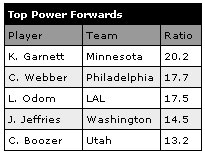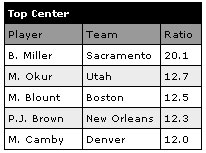Who's the best passer in basketball?
That seemingly simple question can generate a multitude of responses. The obvious first guess is the league leader in assists, Steve Nash. But does that distinction really mean he's the game's best passer? After all, Andre Miller led the league in assists three years ago, and nobody was comparing him to John Stockton.
For more evidence that you won't find the answer by looking at the league leaders in assists, check out some of the other names near the top. They include players like Stephon Marbury (third) and Allen Iverson (fifth), both of whom seem to greatly prefer shooting to passing. Then there's Steve Francis (ninth), of whose passing skills the Magic are so enamored that they have moved him off the point.
So there's more to being a great passer than just racking up assists. If a player dominates the ball all game, he should be getting a lot of assists. But that doesn't necessarily make him Magic Johnson.
To properly answer the question, we must consider other players who might have the ball in their hands less often, but are better at finding the open man when they get it. The Barry brothers, for instance, don't handle the rock much, but both Jon and Brent seem to have eyes in the backs of their heads.
Additionally, it's much easier to pick up assists from the backcourt than it is from the frontcourt. Lakers center Vlade Divac, though injured at the moment, would pick up several votes from players if they were asked to name the game's best passer. Yet one wouldn't divine that from his career average of 3.1 assists per game.
Thus, we need a better method for pinpointing the best passers, which entails making two important distinctions. First, we need to evaluate players based on how often they have the ball. For instance, if Doug Christie touches the ball only four times the entire game but assists a basket on three of them, he's done a heck of a job seeing the floor. Second, we need to differentiate players by position. Big people have far fewer chances to initiate the offense than the guards do, and it shows in the big guys' assist numbers.
Let's start with the first item, leveling the playing field for passers based on how many touches they get. Using a tool I call "Assist Ratio," we can measure the percentage of the plays a player makes that result in an assist.
To calculate Assist Ratio, begin by figuring out how many possessions that player used. Just sum his assists, turnovers and field goal attempts. Then multiply his free-throw attempts by 0.44 and add that to the sum (as I've mentioned in previous columns, the average free-throw attempt is worth 0.44 field-goal attempts). Finally, divide the player's assists by that total: Assist Ratio = Assists / (FGA + (FTA * 0.44) + Assists + TO) |
 |
But don't put down that calculator just yet. Those of you who are still awake may have noticed that in trying to even the playing field, we've tilted it too far in favor of players who hardly do anything at all. That is, a player could post an outstanding Assist Ratio even if he wasn't a good passer, simply by never shooting. If he got only a few dumb-luck assists, like passing to a guy who makes a contested 25-footer with two seconds left on the shot clock, his Assist Ratio would still be great because there'd be no other plays to offset it. |
 |
For an extreme example, consider Washington's Michael Ruffin. He comes as close to "never shooting" as anyone who has ever played the game, with a microscopic average of 3.4 points per 40 minutes. Consequently, Ruffin's Assist Ratio is 26.3, easily the best of any big man in the game. Yet as Wizards supporters can attest, Ruffin handles the ball as if he hears something inside it ticking. Thus, we need to adjust the formula so inert offensive players like Ruffin don't dominate the leaderboard. To accomplish that, let's start with the denominator in the Assist Ratio formula above: the number of possessions a player uses. The league average in this stat is 21.0 per 40 minutes, which we'll use as a benchmark. For any player who falls short of 21.0, we'll increase the possessions in the denominator until it meets 21.0 (call it the blackjack rule). If a player is close, as are the vast majority who fall short, this adjustment barely affects the result. But the blackjack rule is much harsher on the Ruffins of the world. In that way, the final result focuses our attention on the truly gifted passers. |
 |
By this measure, Nash, the league's leading assist man, ranks behind two others, Knight and Brunson, who play smaller roles in their teams' offenses. But the bigger story is that all five are point guards. While each is a superb passer, the fact remains that it's much easier to rack up assists at the point than at the other four spots. The top 29 players in Assist Ratio play the point, and it's unfathomable that the 29 best passers in the game all happen to play the same position. So let's forget about the point guards for a minute and look at the leaders at other positions. Position-by-position comparisons highlight the game's standout passers: Nick Van Exel leads the way among shooting guards with a ratio of 25.0, and is followed by Christie's 24.9. Although he's played the majority of his minutes at shooting guard in the Blazers' miniature backcourt, Van Exel is a bit of a ringer since he's a natural point guard. Thus, if the question is, "Who is the best passing off guard in basketball," Christie is my answer. |
 |
Lebron James' ratio of 22.6, tops among small forwards, proves he warrants his reputation as such a gifted passer. For a wing player, an extremely high percentage of his possessions result in assists. He'll never lead the league unless he starts stealing the ball from Jeff McInnis at midcourt, but that doesn't make his skill at finding the open man any less devastating.
Kevin Garnett (20.2) and Chris Webber (17.7) are both renowned for their skills in seeing the floor from the high post, so there's no surprise they stand first and second among power forwards. Like James at small forward, Garnett has a sizable margin over the competition.
And then there's Brad Miller, who one can argue is the best passer in the game right now. His 20.1 Assist Ratio doesn't seem remarkable until you look at it in the context of what other centers produce. Miller's assist production is nearly twice that of the next closest center, Okur. Moreover, this is a down year for Miller. Last year, his Assist Ratio was 23.4.
Yes, this has something to do with how the Kings use him as a high-post conduit for the offense, but the next four guys on the list aren't exactly total strangers to the high post either. Thus, while Miller's average of 3.9 assists per game doesn't fly off the page, his skill in getting open shots for teammates is simply a cut above that of the league's other centers. Of course, one could just as easily make a case for Knight, James or Garnett (who could probably match Miller's totals if he played center) as the game's premier passer. That's because the vast differences between positions make it very difficult to compare players who play different spots on the floor. As a result, Assist Ratio alone can't settle this debate. Nonetheless, it's a very useful tool for identifying the top performers at each of the five positions. Based on Assist Ratio, it's abundantly clear that if the NBA voted an "All-Passing team" at year-end, Brevin Knight, Doug Christie, LeBron James, Kevin Garnett and Brad Miller should be the five names on writers' ballots. As to which of those five is the best … I think I'll pass. |
 |
By John Hollinger , ESPN Insider